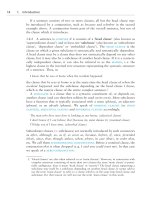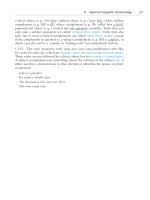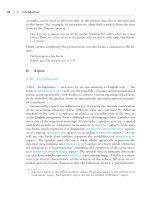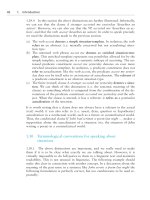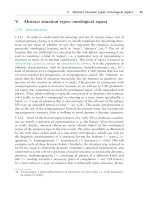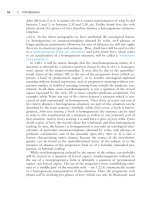The grammar of the english verb phrase part 40 potx
Bạn đang xem bản rút gọn của tài liệu. Xem và tải ngay bản đầy đủ của tài liệu tại đây (73.95 KB, 7 trang )
266 5. The absolute use of the present perfect
2003 that I have been living here is odd because its default reading is ‘I haven’t
been living here long, in fact (only) since 2003’ rather than ‘I could have lived
here before 2003 but have only lived here since 2003’.
In sum, in the sentences that are unacceptable (in isolation), the phrases that
are supposed to function as the value of a specificational sentence are unsuit-
able values because they are not clearly contrastive. This renders the sentences
unacceptable. However, this problem does not arise if the sentences are used
in a suitable context inviting a ‘contrary to expectation’ reading (which is a
kind of contrastive interpretation), irrespective of whether it is the value con-
stituent that is contrastive or the variable constituent:
[It isn’t since I moved to Berlin,] it’s since the fall of the Berlin Wall that I have been
in contact with my cousins in the west. (Since the fall of the Berlin Wall contrasts
with since I moved to Berlin, which is echoic: someone has intimated that it is since
I moved to Berlin that I have been in contact with my cousins in the west.)
[“You have been working in this town since 2003?” Ϫ No, I’ve been working in this
town since 1998.] It’s since 2003 that I have been
living
here. (Here the relevant
contrast is to be found in the variable constituent.)
Two further things should be noted here:
(a) If the highlighted constituent of the cleft is a since-constituent, the that-
clause sometimes evokes a mixture of indefinite and continuative reading:
[She was Ellen Leicester, and Mr. Castonel ran away with her, and she died. That
was last spring,] and it’s since then that Mr. Leicester has got so ill. (www)
[Let me recap the everyday story of teacher training folk, just the edited highlights.
I’ll begin in the 1980s after the Robbins period. (…)] It’s since then that much has
gone wrong, since then that the confusion has set in. (www)
[Unfortunately, the American company I was working for, pulled all of their devel-
opment out of the UK last year. While I could have had a job with them in the
USA, I didn’t really want to bring my children up over there, so I accepted redun-
dancy.] It’s since then that I’ve discovered just how bad the IT sector is at the
moment. (www)
The forms has got, has set in and have discovered are indefinite perfects in the
sense that the literal meaning of get (ill), set in and discover is inchoative: these
(more or less punctual) situations constitute the beginning of a longer period.
However, the above sentences foreground the full resultant states (of Mr.
Leicester being ill, of there being a state of confusion and of ‘my’ knowing
how bad the IT sector is at the moment) rather than the initial point of these
states only, so that the indefinite reading is rejected in favour of a continuative
state interpretation. (In the first example there is surely no possibility that Mr
Leicester could be well at speech time, which there ought to be if the meaning
were purely indefinite.)
V. More on the up-to-now reading of the perfect 267
(b) As noted in 5.20.2, cleft sentences alternate with other types of specifica-
tional structures, some of which consist of one clause only. Thus, there is
no difference of interpretation between the following:
[“Who did this?”] Ϫ “It was Maud who did this.”
[“Who did this?”] Ϫ “
Maud did this.”
In the same way, there is no interpretational difference between the following:
It’s four weeks that she’s been missing now.
She’s been missing for
four weeks now.
Both sentences are interpreted in terms of a presupposition ‘She’s been missing
for x time’ (which receives a continuative reading) plus a specificational speech
act ‘x ϭ four weeks’ (which reminds us of a constitution reading). The only
difference between the two examples is that in the cleft sentence the presupposi-
tion and the specification are encoded as two separate clauses, whereas they
are encoded within the same clause in the noncleft version.
5.21.3 There is another special type of construction in which a constitution
reading is combined with a continuative reading.
When a present perfect sentence receiving a constitution reading expresses
the number of times a (kind of) situation has actualized in the pre-present, the
situation referred to by the present perfect tense form is a ‘hypersituation’
consisting of several ‘subsituations’ Ϫ see 5.19.4. In that case it is possible that
the last of the subsituations is still in progress at t
0
.
This is the third time I {have watched / *am watching / *watch / *have been
watching} this film. [I like it.]
The cigarette I’m smoking now is the third I {have smoked / *am smoking /
*smoke / *have been smoking} today.
This is the first cigarette I {have smoked / *am smoking / *smoke / *have been
smoking}. (The set of subsituations here is a singleton. The one subsituation in
question is actualizing at t
0
.)
It is telling that neither the present tense nor the progressive form can be used
in the relative clause of such examples, even though the last (or even only)
subsituation is interpreted as in progress at t
0
. This is because of the quantifica-
tional constitution interpretation:
(a) The speaker does not use the present tense because his primary concern is
not with the fact that a subsituation is actualizing at t
0
but rather with the
question of how many subsituations have actualized in the pre-present.
That the time of the full situation whose situation time is located at the
end of the pre-present may include t
0
is not expressed by the perfect, which
only expresses that the situation time of the hypersituation is contained in
268 5. The absolute use of the present perfect
the pre-present. (In this case ‘contain’ is interpreted as ‘coincide with’.)
The present perfect says nothing about the possible continuation of the
full hypersituation into the present. In the above examples the idea that
the last subsituation of the full hypersituation includes t
0
is evoked by the
use of This is … or by The cigarette I’m smoking now is … .)
(b) Because a quantificational constitution reading is always W-bounded (see
5.4.5 and 5.19.1), the progressive form (which triggers L-nonboundedness)
is incompatible with such a reading. This is why we cannot say *This is
the third cigarette I’ve been smoking today, even if the last subsituation is
in progress at t
0
Ϫ see also 5.29.2Ϫ3.
However, in the following paragraphs we will draw attention to an exception
to principle (a). An exception to principle (b) will be discussed in section
5.29.2Ϫ3.
There is one apparent exception to rule (a): the present tense can be used if
it represents the post-present actualization of a situation as pre-determined by
present circumstances. (This use of the present tense has been discussed in 3.8Ϫ
9.) The following example illustrates this:
This is the last visit I {am paying / *have paid / *have been paying} you. [You will
never see me again.]
In this type of sentence the presently ongoing situation again forms part of a
pre-present series. However, the speaker no longer focuses on the idea of ‘pre-
present series’ Ϫ the idea of how many times a situation has actualized in a
period leading up to t
0
Ϫ but is concerned with the post-present. The predomi-
nant idea is not that there have been similar situations before the present one
but that there are not going to be any similar situations after this. This means
that the present tense form am paying refers to the future rather than to the
present: it is an instance of how a present tense can be used as a ‘futurish’ form
to refer to the post-present (see 2.9). The above example therefore expresses
something like ‘I am not paying you any more visits’, which can come close in
meaning to ‘I refuse to pay you any more visits’. This use of the present tense
is further illustrated by the following:
This is the best meal we’re giving you. [So make the most of it.]
This is the worst meal we’re giving you. [So don’t despair.]
In both cases the present tense refers to the post-present: ‘You will not be given
a {better / worse} meal than this’.
There are two further pieces of evidence supporting this analysis. Firstly,
sentences like This is the first time I am paying you a visit can only be used if
the speaker is phoning the addressee, or writing a letter to him, since the ad-
dressee cannot be with the speaker at speech time. The following is a suitable
context for the sentence to be used:
V. More on the up-to-now reading of the perfect 269
[I’m coming to see you tomorrow.] This is the first time I am paying you a visit, [so
I’m looking forward to meeting you.]
Secondly, replacing the progressive present tense by the nonprogressive present
is only possible if the situation in question forms part of a habitual routine:
This is the worst meal we give you.
The use of give is only acceptable on an understanding that the meal-giving
forms part of a habitual routine, and ‘you’ really means ‘not only you but
anyone who is in your position’. This is the case, for example, in the follow-
ing context:
[Anyone who stays at this monastery for a week gets a good meal most days Ϫ for
example, it’s roast duck on Saturdays and beef casserole on Sundays, but on Mon-
days it’s always boiled tripe, and here’s yours. Don’t worry,] this is the worst meal
we give you.’
As noted in 3.8, forming part of a habitual routine is a typical instance of how
a post-present situation can be viewed as ‘pre-determined’ and can therefore
be referred to in the nonprogressive present tense.
15
5.22 Summary of part V
5.22.1 We speak of an up-to-now reading if the full situation is taken to cover
the entire pre-present, i. e. if the full situation leads up to t
0
in such a way that
it does not include t
0
and that there is no significant interval between the end
of the full situation and t
0
.
5.22.2 One type of up-to-now reading is the constitution reading. Here the
speaker looks back on the pre-present to ‘measure it’ or to see how this period
has been filled ‘situationwise’. The speaker thus focuses on the situational con-
stitution of the pre-present zone and not only on the temporal location of a
situation on the time line. On the constitution reading the pre-present may be
filled either by one full situation which actualizes throughout the pre-present
period (but without including t
0
) or by a number of full situations which (pos-
sibly in combination with gaps) form a ‘hypersituation’ which coincides with
the pre-present but does not include t
0
. In the latter case, the number of consti-
tuting subsituations may be zero, one or more.)
15. Things are different in the following sentence, where give is not used as a futurish
form (establishing a post-present domain) but as a ‘pseudo-absolute’ present tense form
expressing simultaneity in the post-present domain established by the head clause (see
9.17.3):
[You will get some food tonight.] This will be the first and only meal we give you today.
270 5. The absolute use of the present perfect
5.22.3 There are three subtypes of constitution reading:
(a) The speaker may be concerned with the nature of the situation that is
conceived of as having lasted throughout the pre-present without including
t
0
(e. g. What have you been doing?; Where have you been?). In that case
there is a nonquantificational constitution interpretation.
(b) The speaker may be concerned with the length of the pre-present and
indicate this by a bounded present perfect sentence referring to a duration-
specifying situation (e. g. Nearly a year has gone by since then). In that
case there is a duration-quantifying constitution interpretation.
(c) The speaker may also be concerned with how many times a specific situa-
tion (or kind of situation) has actualized in the course of the pre-present
(e. g. How many times have you met him in the past week?). In that case
there is a number-quantifying constitution interpretation.
In all three constitution readings, the time of the full situation coincides with
the situation time (ϭ the time of the ‘predicated’ situation), which coincides
with the pre-present zone, which does not include t
0
. This means that the full
situation is always W-interpreted as bounded: in each case the right boundary
is the point of time immediately preceding t
0
.
5.22.4 An up-to-now reading which is not a constitution reading is an un-
marked up-to-now reading. Sentences receiving this reading often have an ex-
planatory-resultative function.
VI. The relation between the W-readings and (non)progressive aspect 271
VI. The relation between the W-readings and
(non)progressive aspect
5.23 (Non)progressive aspect and a continuative
nonhabitual reading
A continuative interpretation is by definition a progressive interpretation (even
though stative verbs do not allow the use of the progressive form): the full
situation that started before t
0
includes t
0
, i. e. is still in progress at t
0
.
It is therefore not surprising that, when the conditions for using the pro-
gressive form are satisfied (minimally: the verb phrase is compatible with the
progressive form and the reference is not to a permanent habit or characteris-
tic), a present perfect sentence referring to a single situation which is to be
interpreted as continuative normally uses the progressive form, though this
‘rule’ is less strict if a continuative interpretation is anyhow enforced by an
adverbial like ever since or for the past two hours. This is illustrated by the
following examples:
John has been working on his dissertation for two hours. (continuative)
John has worked on his dissertation for two hours. (indefinite reading possible)
John has worked on his dissertation for the past two hours. (continuative)
In sum, if the speaker refers to a dynamic (ϭ nonstatic) situation and wants
to express progressive meaning Ϫ in this case: the idea that the pre-present
situation is still ongoing at t
0
Ϫ he will normally use the progressive form.
This is in keeping with the Gricean Maxims. A speaker will not normally be
understood as wanting to represent a dynamic situation as still continuing at
t
0
if he uses a nonprogressive present perfect in a context where the progressive
form is grammatically possible. In other words, if the progressive is grammati-
cally available and not used, the speaker is understood not to wish to convey
progressive meaning and thus not to wish to convey continuative meaning.
5.24 (Non)progressive aspect and a continuative habitual
reading
5.24.1 It is typical of repetitive habits that, irrespective of the time zone in
which they are located, the progressive form represents them as
temporary
habits
, whereas the nonprogressive form represents them as permanent hab-
its
, i. e. as not restricted in time:
272 5. The absolute use of the present perfect
I’m writing poems these days. (temporary habit)
I write poems. (permanent habit)
In those days Shakespeare was writing sonnets rather than plays. (temporary habit)
In those days Shakespeare wrote sonnets rather than plays. (permanent habit: in the
restricted period indicated by in those days it was a permanent characteristic of
Shakespeare that he wrote sonnets rather than plays.)
The same is true when the present perfect is used on a continuative interpreta-
tion. (Remember that in the present section Ϫ section 5.24 Ϫ we are only
concerned with the continuative interpretation.)
Ever since I was fifteen I have slept only five hours a night. (The sentence asserts
the continuative repetition of the situation of the speaker sleeping only five hours a
night, which constitutes a continuative permanent habit.)
I have been sleeping ten hours a night since we have been on holiday. (The continua-
tive repetition of situations is taken to constitute a temporary habit.)
Jimmy, 41, a former pit worker at the Bevercotes colliery, in Ollerton Notting-
hamshire, has looked in vain for work ever since. (www) (Ever since enforces a
continuative reading. The progressive form is not used, because the speaker treats
Jimmy’s looking for work as constituting a permanent habit rather than a temporary
habit or a single nonhabitual situation.)
It is the same mixture of cunning and inspiration which has helped Morita’s business
career to prosper ever since. (www) (similar)
16
He has used his physical shortcomings to advantageous effect ever since. (www)
(Ever since enforces a continuative reading. The reference is not to a single situation
of using physical shortcomings to advantageous effect but to repeated use of this
device, which has become characteristic of the referent of the subject NP. By using
has used the speaker represents that characteristic as a permanent habit. He could
also have used has been using, which would have represented the habit as still tem-
porary.)
We’ve only {been working /
?
worked} as waiters for four days, [so we haven’t ac-
quired a lot of experience yet].
[I’m ninety-two and] I {have had /
??
have been having} long walks in the country
since I was four.
I{have written / have been writing} books ever since I started working at the univer-
sity. (In this case each subsituation is telic because the underlying proposition is ‘I
write a book’. However, the habitual hypersituation as a whole is not telic, because
a habit is a state. The use of the nonprogressive form therefore does not represent
the situation as L-bounded and forms no obstacle to the continuative interpretation.)
16. One might object to our speaking of a habit here because the speaker does not attribute
a habit to the referents of the coordinate subject NP. (He could hardly do so because
these referents are inanimate.) However, this is beside the point. What counts is that it
has been characteristic of Morita’s business career that it has prospered ‘ever since’.



